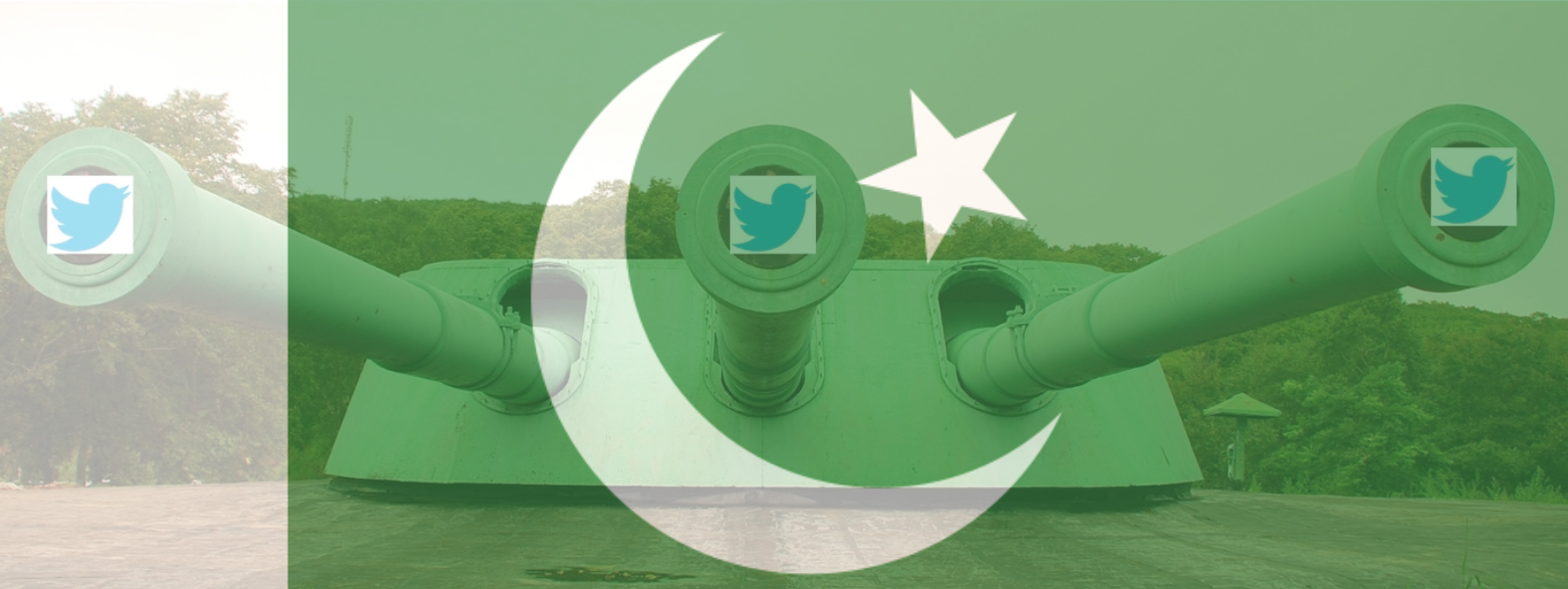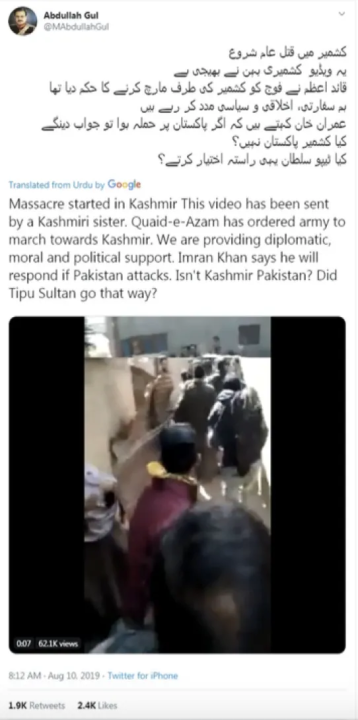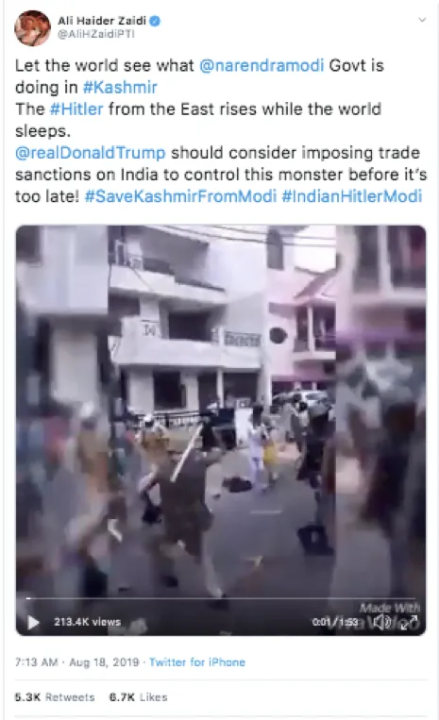Dueling Kashmir narratives on social media, part 1: Pakistan
Indian and Pakistani users amplified misleading content on social media in the wake of Kashmir’s digital blackout
Dueling Kashmir narratives on social media, part 1: Pakistan

BANNER: (Source: @DfrKaul/DFRLab, @disinformediain/DFRLab via Unsplash and Bannersnack)
This is the first of a two-part series looking at the use of social media in Pakistan and India in the aftermath of the latter’s digital blackout in Kashmir.
In the days following the Indian authorities’ early August digital blackout of Kashmir, Indian and Pakistani social media users amplified misleading content, much of which went viral after public figures and media outlets republished it.
With an estimated 640,000 new users from around the world coming online every day over the past five years, the frequency of network shutdowns instituted by governments — often with the stated aim of hindering the spread of disinformation campaigns aimed instigating civil unrest following significant political events — has also increased. Access Now, a digital rights nonprofit, identified 196 instances of internet shutdowns instituted by governments in its 2018 report on internet freedom, with India accounting for 67 percent of global shutdowns that year. Open-source data compiled by the Software Freedom Law Center, a digital rights NGO, recorded 55 instances of internet shutdowns imposed by the Indian government in Jammu and Kashmir in the first half of 2019 alone, with many of these digital restrictions justified by the authorities on the basis of security considerations.
Despite the popularity of these measures among governments as a means of preemptively stopping the spread of false information, there is a growing chorus of journalists and digital rights activists who question the efficacy of this tactic, highlighting the many damaging side effects on the affected communities. Moreover, the flurry of misinformation circulating online in the wake of India’s recent internet shutdown in Kashmir also provides an important case study of how the imposition of an informational vacuum can, in turn, fuel the spread of false or misleading information.
Some of the misleading content resulting from the Kashmir shutdown conformed to existing ideological biases. Pakistani users shared content about the perceived injustices carried out by the Indian armed forces against Kashmiri civilians. Meanwhile, Indian users amplified poorly contextualized and doctored videos that characterized Kashmiri Muslims in the Pakistan-administered section of the disputed territory as revolting against the Pakistani government.
A digital blackout in Kashmir
On August 4, the Indian government — at the direction of Prime Minister Narendra Modi — put the disputed state of Kashmir on lockdown. The following day, it unilaterally diluted Article 370 of the Indian constitution governing the special status of Kashmir and its neighboring region Jammu, via presidential order. This change in status represented a consequential shift in New Delhi’s troubled relations with its northernmost state.
Initially designed as a “temporary provision” when it was added into the Indian constitution in 1949, Article 370 accorded Jammu and Kashmir a special status within the Indian union, exempting their residents from being subject to the Indian constitution as well as allowing their governments to draft their own constitution and laws. The effective outcome of this provision was self-governance for all matters except those related to the fields of finance, defense, foreign affairs, and communication.
A related provision, Article 35A, prevented those not designated as “permanent residents” from owning property and land in the region, while also conferring special rights and privileges to locals, including preferential access to government employment, scholarships, and other forms of state welfare. Over time, both amendments became highly symbolic for many residents of Jammu and Kashmir as a legal guarantor of their unique identity within India’s wider population.
In contrast, the scrapping of both provisions had been an integral component of the political agenda of Hindu nationalist and right-wing movements in the country since the 1950’s, in part out of a perception that the preferential treatment accorded to permanent citizens under both articles fostered a degree of separatism amongst the locals and undermined their full integration into the rest of the country.
Cognizant of the popularity of both provisions among locals and the elevated risk of popular protest at its dismissal, the Indian authorities deployed over 40,000 additional security forces a day before formally announcing the sweeping changes in parliament, and implemented a comprehensive physical and communications blockade over large parts of the state.
The Washington Post highlighted how Indian authorities severed private mobile networks, internet services, and telephone landlines and implemented Section 144 of the code of criminal procedure, which prohibits the assembly of more than five individuals in a public space. The territorial status of Jammu and Kashmir has been at the heart of the historical rivalry between India and Pakistan for over 70 years.
A valley in flames
Shortly after the announcement regarding Article 370, multiple Pakistani politicians, including Senator Rehman Malik and Federal Minister for Maritime Affairs Ali Haider Zaidi, amplified old and edited videos purporting to show alleged human rights violations by Indian security personnel against Kashmiri citizens protesting the recent blackout and sweeping political changes. Other posts included old clips falsely presented as footage of recent demonstrations against the Indian government.
@MAbdullahGul, a Twitter account belonging to Abdullah Gul, the director general of the Measac Research Centre, a Rawalpindi-based think tank, and the son of former director of the Pakistani intelligence services Hamid Gul, uploaded a video on August 10. Abdullah Gul claimed that the video showed Indian security forces carrying out atrocities against civilians.
In particular, the video reportedly showed the aftermath of an attack as Kashmiri locals carried injured civilians away. The tweet included a caption in Urdu that claimed that a “[m]assacre had started in Kashmir” and that “Quaid-a-Azam (PM) has ordered army to march toward Kashmir.” At the time of analysis, the video had been viewed more than 62,000 times.

The video was swiftly debunked by AltNews, an Indian fact-checking outlet. AltNews identified the video to be of an explosion at the site of a gun battle between militants and security forces in the town of Kulgam that had taken place in 2018.
Three days later, former Pakistani Interior Minister Rehman Malik uploaded the same old video from the Kulgam blast, calling on U.S. President Donald Trump, the United Nations, and Human Rights Watch to “take notice of this Indian gunship attack on innocent Kashmiris.”

Similarly, the current Pakistani Federal Minister of Maritime Affairs, Ali Haider Zaidi, uploaded a video to his Twitter account showing a large mass of protesters, some carrying Pakistani flags, with a caption indicating the video was of a recent protest of “millions of Kashmiri” against the Indian government.
Boom Live, an Indian fact-checking outlet, discovered that the clip was lifted from an older video on YouTube that showed the high attendance of locals at the 2016 funeral of slain insurgent Burhan Wani. The DFRLab has previously examined the popularity of Wani’s method of social media insurgency and the adverse effect that the adoption of his methods by insurgent and terror groups operating on the valley has had on the enduring insurgency in the state.

Another tweet uploaded by the same user on August 18 contained an edited video that purportedly showed multiple examples of police brutality by Indian forces against Kashmiri civilians. The video was accompanied by a caption that called on the international community to “see what Narendra Modi’s government is doing in Kashmir” and implored U.S. President Donald Trump to impose trade sanctions against India in order to “control this monster.”
This video was similarly debunked relatively quickly, when AltNews published a story the day after the initial post in which it identified the video to be a compilation of two unrelated clips. The first clip showed a 2017 confrontation between police and protesters in Haryana, while the second was from a 2018 news clip about a sting operation against a police officer from the Indian state of Telangana.

In each of these cases, the misleading content shared in the tweets was debunked by local fact-checking outlets on the same day as the content was uploaded. The tweets, however, are still live, with the videos having cumulatively accrued more than 6 million views at the time of analysis.
In each of the cases examined, the posts furthering the misleading content gained significant engagement from users on the platform. In contrast, the tweets from the fact-checking outlets debunking the incorrect tweets received less attention, demonstrating the uphill struggle that fact-checkers often face when combating the spread of mis- and disinformation online.

Part 2 of this analysis examines the opposing narrative employed by Indian social media users.
Follow along for more in-depth analysis from our #DigitalSherlocks.

